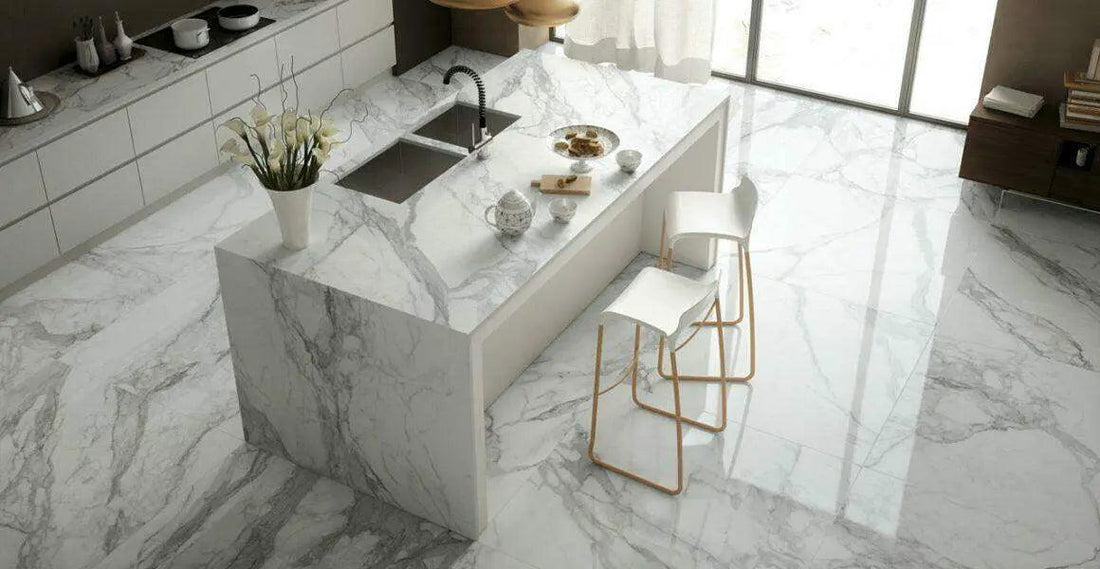Marble: The Epitome of Elegance, Luxury, and Timeless Beauty
by Shivam Tayal 19 Feb 2025 0 Comments
Introduction On Marble
- Marble has been seen for a long time as the most luxurious, elegant and timeless natural stone which is used in architecture, art and interior design projects
- It is known for its distinctive veining, smooth texture and a unique shine
- Marble is a metamorphic rock which is formed from limestone subjected to immense heat and pressure below the Earth's surface over thousands of years, due to this it develops a crystalline structure and unique patterns which make each slab one of a kind.
- It caters to a diverse range of design preferences as it is available in a wide variety of colours, patterns and finishes from Carrara marble with subtle grey veining to luscious green, black or even gold marbles
- It is also very durable and long-lasting when it is properly cared for because it requires regular maintenance due to its porous nature and may cause etching from acidic substances.
- Over time it has the ability to add a layer of patina which further adds character and charm to the place.
- It has been used in many monuments of the world like the Parthenon in Greece and the Taj Mahal in India
- Natural stone like marble can be seen as a sustainable and environment-friendly material if proper guidelines are followed during the extraction process thus making it a top choice for architects and homeowners.
History and Evolution of Marble Stone
- The history of this stone goes back thousands of years as its usage was deeply rooted in the artistic, architectural, and cultural heritage of ancient civilisations.
- The word 'marble' is derived from a Greek word 'marmaros' which means "shining stone" thus representing the stone's natural brilliance and light-reflecting qualities.
- Civilisations like the Greeks and Romans were seen as the first to recognise its true potential as a construction and artistic medium.
- Monuments like the Parthenon and Pantheon are some examples which show the stone's true beauty and structural strength.
- Taj Mahal was made from Makrana marble which makes it seen as a symbol of love and architectural brilliance.
- In the Renaissance period, artisans mostly used marble to make sculptures, cathedrals and palaces all across Europe
- After the industrial revolution, marble became more accessible to people worldwide as its quarrying and transportation technologies improved.
- In modern times their have been further innovations in this industry like computer-controlled cutting technologies and advanced sealing machines which allow marble to be cut in thin slabs and customised patterns with high precision
- Due to this, today marble has become an integral part of our architecture not only for making grand structures but also in residential and commercial spaces as it timeless charm always inspires architects.
Application of Marble
- There are a lot of applications for marble stone as it is very versatile and has a lot of functional benefits spanning residential, commercial, and monumental spaces
- For residential spaces, marble is used a lot in kitchen countertops, bathroom vanities, and decorative accents where we could maximise its natural elegance and reflective surface and elevate the visual appeal of any space.
- For modern kitchens and bathrooms, stones like Carrara or Calacatta which is white marble with subtle veining as create a clean and sophisticated ambience
- In luxury homes and bungalows, use marble for grand staircases, wall cladding and ornate tabletops which adds character and charm to the area
- For commercial spaces, marble is mostly used in hotel lobbies, office reception and upscale restaurants as it creates a great first impression and long-lasting durability.
- Public buildings, monuments, and places of worship also benefit from marble's grandeur and cultural significance, as seen in historic cathedrals, government buildings, and museums worldwide.
- Its ability to be cut, shaped, and polished into intricate patterns and forms makes it a highly customisable material, capable of fitting into both classic and modern design aesthetics.
Installation Process of Marble
- Proper installation of Marble is important for longevity and functionality as it requires precision, expertise and attention to detail
- The first step is site preparation, in which ground is carefully leveled and excavated to create a strong base
- After this, a layer of sand and mortar mix is applied on the surface which is then evenly spread across the surface to create a strong base for the stones
- Then comes the most important step which is the placement and alignment of the stone to create a seamless look.
- After the stone placement, a high-quality adhesive and mortar mix were applied to secure them into their position
- Then joints between the stones are filled with grout or polymeric sand depending on the usage, excess grout is then cleaned and carefully wiped to prevent any residue buildup
- For outdoor installations, a sealant is applied to protect the stones from stains, moisture infiltration, and environmental damage, ensuring long-term durability.
- After these steps, we can make sure that the stone is so strong and durable that it could withstand for many years while continuously offering its timeless charm and elegance.




